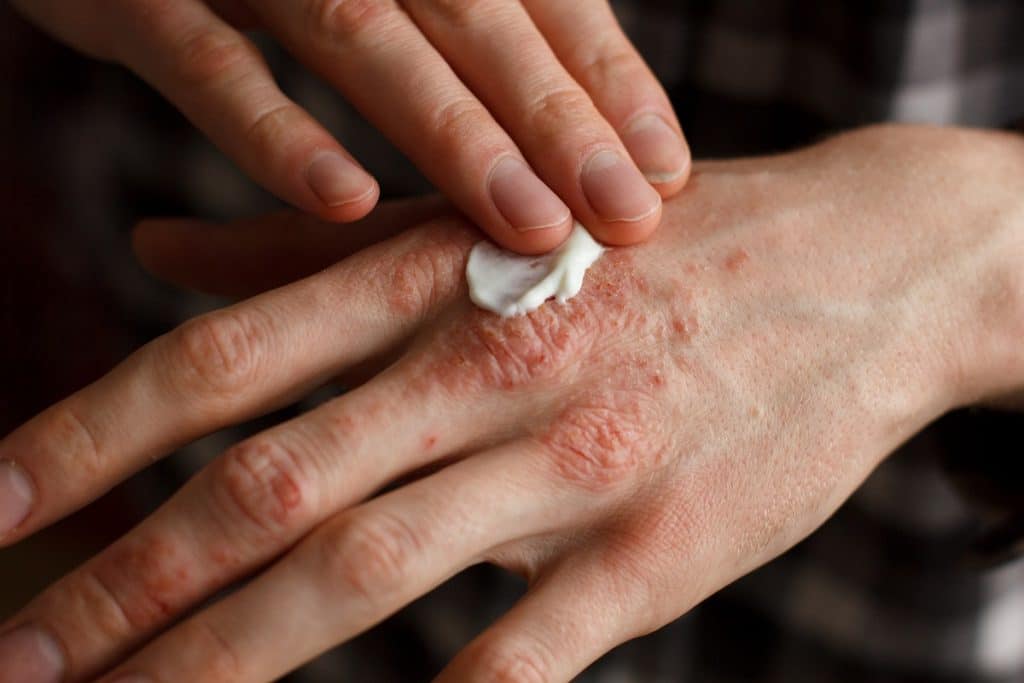Leave Unbearable Itchiness Behind And Step Into The Rays Of Infrared Light
Psoriasis is a chronic skin condition that affects more than eight million Americans, who all live with the stark reality of an unknown cure. Psoriasis is not your typical skin rash; it is, in fact, a systemic illness, considered by most health care practitioners as an autoimmune disorder.
Beyond a skin irritation, this deeply uncomfortable skin condition is associated with other serious illnesses such as Parkinson’s disease, kidney disease, celiac disease, and type II diabetes. The diagnosis of psoriasis should not be taken lightly. By addressing the systemic issues that are causing the flare-ups in skin irritation, it may be possible to ward off future developments of more lethal conditions.
Most psoriasis patients are directed toward symptom management through pharmaceutical treatments that address symptom control as a topical ointment and usually through some form of cortisol or prednisone treatment. Recognizing the development of psoriasis as a red flag for the potential development of more serious autoimmune disorders helps to set the course right by addressing some of the underlying causes.
So, how can infrared sauna therapy help with psoriasis?
Broad spectrum Infrared sauna treatments are excellent for a variety of autoimmune disorders because of the unique effect that the infrared light spectrum has on the molecular and cellular network of the body. Infrared sauna therapy encourages the shedding of the excessive skin growth causing the uncomfortable, patchy, swollen, and red zones on the skin caused by psoriasis. Not only will patients suffering from psoriasis find symptom relief, but also equilibrium is found within the body as ATP production is increased with exposure to the infrared light spectrum. Further, infrared saunas interact with the autonomic nervous system to create states of relaxation and homeostasis in the body.
Find symptom relief from itchiness and soreness caused by psoriasis and also heed the warning that this condition carries with it regarding further development of chronic disease in the body with regular infrared sauna therapy.
What Is Psoriasis? Whom Does It Affect, And What Causes It?

Psoriasis is a chronic condition that is outwardly expressed as irritation to the outer layer of the epidermis. Internally, however, the stakes are much higher, psoriasis is an autoimmune condition, that when inactivation causes a surplus of skin production. This results in a miscommunication between the neurons that affects the entire system of the epidermis.
Outbreaks of psoriasis can range from small dandruff like patches around the hairline to full ruptures of the skin over the surface of the whole body. The skin is the largest organ in the body, malfunctions of such a large organ are indicative of imbalance through the entire physiological make-up.
Here is what is happening underneath the initial layer of skin: The real issue is with the immune system sending too many T-cells, and neutrophils (other white blood cells) to regions of the body perceived to be under attack. Due to a miscommunication of the neurons, the brain believes that areas of the skin are under attack and sends too many white blood cells to the area creating excessive skin growth that results in the flaking off of skin.
Under, normal conditions T-cells travel throughout the body to defend against foreign threats, such as bacteria and viruses, in the case of psoriasis, T-cells attack already healthy skin cells. These overactive T-cells trigger the production of healthy skin cells. This can cause lesions in the skin that are pustular, as wells as swollen, itchy, and red. This cycle continues at faster rates, generating more skin in short periods of time, over days rather than weeks and further perpetuates the outward expression of psoriasis. Ultimately the skin builds up in scaling, swollen, and red patches over and over again.
The causative factor behind the excess production of T-cells remains unclear, but medical professionals do believe that genetics coupled with prolonged states of stress response are contributing factors.
There are several varieties of psoriasis and not all are related to incorrect immune response. Guttate psoriasis is typically triggered by a bacterial infection such as strep throat and primarily affects young adults and children. Generally, this form of psoriasis is not chronic and may be limited to a single outbreak that expresses symptoms more closely related to the chicken pox.
There are six other primary expressions of psoriasis, and while their expression varies from one to the other as far as the forming of plaques on the surface of the skin is concerned, they are all symptomatic of an irregular immune response to the skin. Moving, forward, all references to psoriasis will exclude guttate psoriasis and will only focus on psoriasis that results from autoimmune malfunctions.
What Are Some Typical Treatments Used For Psoriasis? Medical Professionals are Now Using Phototherapy In Addition To Pharmaceutical Methods: Infrared Light As A Potential Means To Remission
Treatment methods vary depending on the severity of expressed psoriasis. Most doctors will prescribe topical ointments and creams to address the immediate need for relief from itchy painful plaques (elevated, red, and swollen patches of skin). These creams typically contain cortisol and will help the itching sensation almost immediately. Despite the vanquished symptoms the immune system continues to malfunction and send excessive T-cells to portions of the skin.
Prednisone consumption through pills and cortisone injections are also used to treat psoriasis. Both of these treatment methods do provide resounding short-term relief from systems but may ultimately leave the body in a much worse condition. Side effects of using these treatment options may include heart disease and chronic states of stress response as the sympathetic (fight or flight) branch of the nervous system is in perpetual dominance. Continual and perpetual use of prednisone may place a heavy toll on the heart.
As psoriasis is an indicator of systemic imbalance, the typical treatment methods could ultimately be more hazardous to the health and possibly perpetuate the pathway into more severe conditions such as Parkinson’s disease, Crohn’s disease, psoriatic arthritis, and other autoimmune disorders.
As traditional treatments for psoriasis can be high risk, medical professionals, even in the allopathic field, are turning to other therapy methods that will be more conducive to the overall health of the body and provide symptom relief. The most remarkable of these is phototherapy, including regular exposure to the infrared light spectrum, as well as to medical grade light therapy.
The National Psoriasis Foundation now prescribes phototherapy to its patients. Here is what they have to say about the ultraviolet B (UVB) wavelength:
“Present in natural sunlight and also in greater doses using medical grade light therapy ultraviolet B (UVB) is an effective treatment for psoriasis”

The foundation does go on to warn patients that the external expression of the condition may worsen after the initial light treatments but over several sessions not only will symptoms be relieved, but balance will be found within the immune system.
In addition to the ultraviolet infrared rays, there is further evidence to suggest that the infrared spectrum of light has powerful healing capabilities on psoriasis. If you are suffering from psoriasis you may want to try phototherapy that encompasses both the infrared light spectrum as well as the ultraviolet and other spectrums of light found in medical grade light therapy units.
Carly Barrett, an individual diagnosed with psoriatic arthritis describes her experience with infrared sauna therapy (please note that her unit also included medical grade light therapy of which the ultraviolet spectrum was apart of):
“I was diagnosed with psoriatic arthritis in my twenties. I know it sounds slightly crazy, and I would have a hard time believing this if I didn’t experience it first-hand, but just one 40 minute session in the sauna gave me relief from my muscle pain, stiffness and itchy swelling.”
With both the medical profession and individuals suffering from psoriasis getting on board with infrared sauna therapy and phototherapy to treat this chronic tradition, how do specific light spectrums affect psoriasis and how does infrared light provide relief from this irritating and potentially serious condition?
Infrared Sauna Therapy Provides Relief From Psoriasis Symptoms And Helps To Maintain Balance Of The Immune System
NASA researchers originally discovered the infrared spectrum of light as a healing modality in the mid-1960s; it was found during research that the infrared spectrum of light seriously decreased healing time in burn victims. As research began to permeate the field of biomedicine, it was found that cases of psoriasis also reacted positively to the light exposure of infrared treatment.
So, how does infrared light help with psoriasis?
The infrared light spectrum including, near, mid, and far wavelengths penetrate the skin into the soft tissue of the body, this far-reaching absorption stimulates mitochondrial activity inside the cellular structure. The ensuing cascade of health benefits of infrared sauna therapy from the mitochondrial activity eventually enables the immune system to regain balance and therefore, deter psoriasis from occurring in the first place.
ATP (Adenosine Triphosphate) is increased due to the stimulated mitochondria by the infrared light spectrum. Increased ATP production will allow the skin to accept nutrients faster, and dump waste products more readily. It also increases blood circulation of hyper-oxygenated hemoglobin to inflamed and swollen parts of the body. Increased blood circulation to your skin cells creates new capillaries to replace damaged ones, aiding in reducing inflammation.
Skin lesions from psoriasis will heal quickly with heightened ATP production, but more importantly, the improved circulation will allow the immune system to find states of homeostasis once again, and therefore alleviate the causative factor in psoriasis. As the body adjusts to improved ATP production, neurons are healed of their miscommunication and a normal steady flow of T-cells is resumed.
If you decide to follow an infrared sauna treatment plan, you will want to find a unit that also includes medical grade light therapy. The American Psoriasis Foundation prescribes regular doses of UVB light, which is incorporated into all medical grade light therapy. To find an infrared sauna that includes phototherapy consider Saunas.org to get your full dose of phototherapy.
Infrared Sauna Therapy Balances The Autonomic Nervous System And Detoxifies The Body
The direct cause of psoriasis is still unknown, it is believed by medical practitioners that prolonged states of stress response is a leading causative factor to the development of this autoimmune disorder.
The soft infrared heat of tinfrared sauna therapy will coax the body back into states of relaxation where healing and nourishment can occur. The individual cells of the body will open up allowing the entire physiological system to transfer the autonomic nervous system out of stress response back to relaxation. Individuals suffering from psoriasis need to find systematic ways into relaxation, the gentle warm hues of the infrared light spectrum interact with the body in perfect harmony to induce deep states of relaxation.
Toxic build-up of environmental pathogens that are not processed by the body will add further stress to the internal landscape of the body. As the infrared spectrum of light penetrates into the soft tissues of the body, the internal temperature will rise. As this occurs, a ‘fever’ is induced and the body will begin to work to eliminate toxins out of the body through perspiration. Infrared sauna therapy relies on the largest organ of the body, the skin, to powerfully detoxify the system.
Detoxification protocol will relieve the internal organs from stress and create greater states of balance free from stress within the body. Knowing that prolonged states of stress increase incidences of psoriasis in patients, it makes sense to relieve the body of both external and internal stress.
Relief From Psoriasis Symptoms Could Be A 40 Minute Infrared Sauna Session Away…
Feeling comfortable in your own skin is paramount to experiencing a high quality of life. At times, desperate for relief from all-encompassing sensations of itchiness, individuals suffering from psoriasis may experience lower moods and distance themselves from intimacy. Greatly restricting themselves from activities that they would normally find pleasurable and enjoyable as symptoms of this chronic condition permeate all aspects of being.
In tandem with traditional management treatments for psoriasis, infrared sauna therapy can provide relief from uncomfortable symptoms. Regular infrared sauna therapy also affects the biochemistry of the body to induce more frequent and longer lasting states of relaxation. Stepping into states of relaxation and out of states of stress response will address causative factors in psoriasis
If you or someone you love is suffering from psoriasis, then consider an infrared sauna that also incorporates medical grade light therapy. This will ensure the benefits of both the infrared spectrum as well as exposure to the ultraviolet spectrum (known to reduce psoriasis symptoms).
Some psoriasis patients have described symptoms as a ‘living hell’; however, there is hope for a complete secession of symptoms. Step into the light of the infrared spectrum and leave itchy and irritable skin behind while you pave the way for a brighter future free from further developments of other chronic conditions.
***Contraindication: Please consult a health care practitioner if you have any questions regarding the use of infrared sauna therapy and psoriasis.
Sources:
https://www.mayoclinic.org/diseases-conditions/psoriasis/symptoms-causes/syc-20355840
https://www.psoriasis.com/what-is-psoriasis
https://www.psoriasis.org/about-psoriasis/treatments/phototherapy


